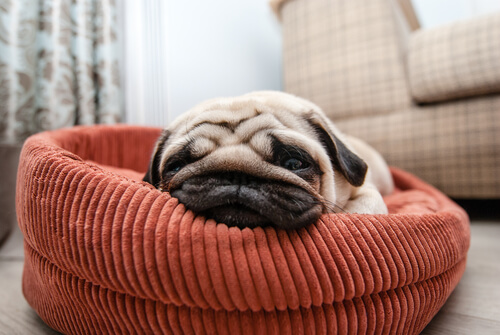Why Do Dogs Sleep All Day Long?

A sleeping dog can be quite a sight. Some snort, grunt, bark and even move their legs, simulating a run through a fictitious park. Since their sleeping hours are unevenly distributed, it can take some time before owners are able to predict their pets’ most active periods.
How many hours of sleep do dogs need?
Sleep patterns in dogs vary by age, size, and hours of daily exercise. Naturally, a puppy will sleep more hours than an adult, and a Saint Bernard will spend more hours sleeping than a Chihuahua
Larger dogs and puppies sleep for an average of 18 hours a day. The sleep cycle of an average adult dog is between 12 and 14 hours.
Although 50% of the hours a dog spends sleeping take place at night, it is normal for him to take various naps spread unevenly throughout the day. The underlying reason for this distribution has to do with his REM phase.
Humans spend 25% of their sleep hours in REM phase, a time of high brain activity in which mammals assimilate the stimuli they have received from their environment.

Dogs, on the other hand, only spend 10% of their hours in this phase. Therefore, to be able to enjoy a suitable amount of rest for their health, they tend to take several naps during daytime hours.
Yes, they dream too!
The characteristic sounds and movements that a dog makes while sleeping prove this fact; these animals are able to dream.
Like any other brain, theirs also needs to process all the information they have collected during the day, and dreaming, as we all know, is the most effective brain mechanism to achieve this.
Exercise is crucial for better canine sleep hygiene
Physical and mental stimulation, both in dogs and humans, is key to maintaining healthy sleep habits. Contrary to what many believe, if our pet does not exercise or receive intellectual stimuli, he will sleep more hours.

A sleeping dog can be quite a sight. Some snort, grunt, bark and even move their legs, simulating a run through a fictitious park. Since their sleeping hours are unevenly distributed, it can take some time before owners are able to predict their pets’ most active periods.
How many hours of sleep do dogs need?
Sleep patterns in dogs vary by age, size, and hours of daily exercise. Naturally, a puppy will sleep more hours than an adult, and a Saint Bernard will spend more hours sleeping than a Chihuahua
Larger dogs and puppies sleep for an average of 18 hours a day. The sleep cycle of an average adult dog is between 12 and 14 hours.
Although 50% of the hours a dog spends sleeping take place at night, it is normal for him to take various naps spread unevenly throughout the day. The underlying reason for this distribution has to do with his REM phase.
Humans spend 25% of their sleep hours in REM phase, a time of high brain activity in which mammals assimilate the stimuli they have received from their environment.

Dogs, on the other hand, only spend 10% of their hours in this phase. Therefore, to be able to enjoy a suitable amount of rest for their health, they tend to take several naps during daytime hours.
Yes, they dream too!
The characteristic sounds and movements that a dog makes while sleeping prove this fact; these animals are able to dream.
Like any other brain, theirs also needs to process all the information they have collected during the day, and dreaming, as we all know, is the most effective brain mechanism to achieve this.
Exercise is crucial for better canine sleep hygiene
Physical and mental stimulation, both in dogs and humans, is key to maintaining healthy sleep habits. Contrary to what many believe, if our pet does not exercise or receive intellectual stimuli, he will sleep more hours.

This text is provided for informational purposes only and does not replace consultation with a professional. If in doubt, consult your specialist.








